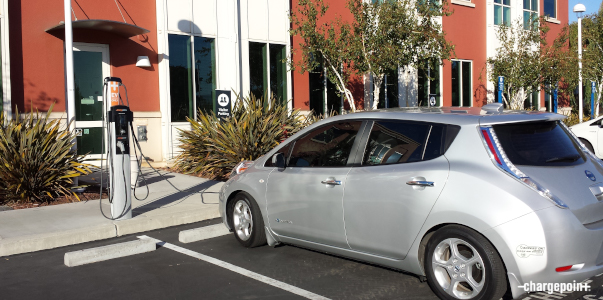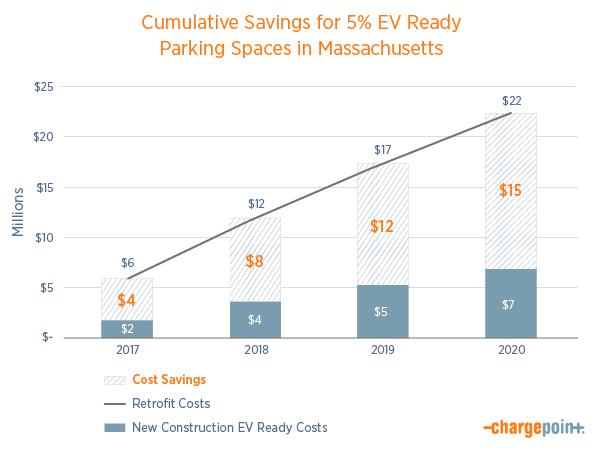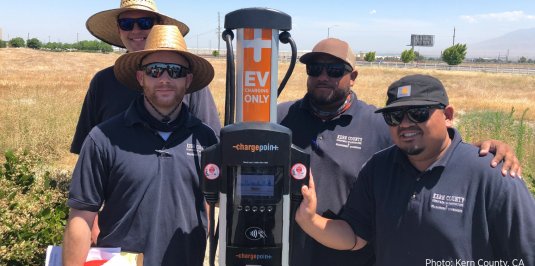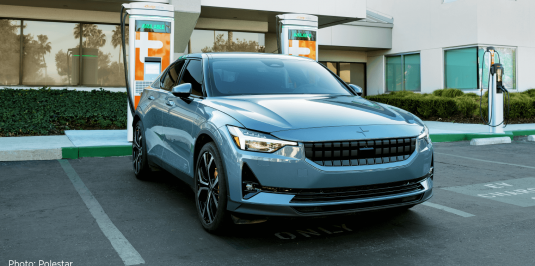
As a contractor, you may already know that electric vehicle (EV) Ready building codes are in place in several cities and states. But do you know how much money EV Ready construction can save you over time, and how it can increase demand for your services? In this post, we explain how EV Ready building code supports the shift to electric mobility, saves money and builds your business, all at the same time.
“The best time to plan for an EV charging station is before someone even knows they want one.”
EVs Are Accelerating
More than 2 million EVs are on the roads worldwide, over 60 new EV models are coming out in the next two years and 25 percent of vehicles sold will have electric motors by 2025. Electrical engineers and contractors like you must get ready now to accommodate these vehicles in parking lots and garages across all types of properties. Failing to prepare now will cost millions later on and could compromise your customer relationships by incurring unexpected costs.
Building codes, as you know, are sets of rules and regulations that govern standards for how residential and commercial buildings are constructed. EV Ready building code can vary by region, but typically requires new building construction to prepare a certain proportion of parking spots for EV charging to be installed at a later date, supporting sustainability goals and EV drivers.
EV Ready Requires Stations and Conduit
While EV Ready building codes can help encourage EV adoption, they don’t always require EV charging stations to be installed at all of the parking spots involved in a project. Instead, EV Ready codes may simply require that a building’s electrical capacity and other infrastructure be ready to install charging when demand increases. EV Ready requirements might include:
-
EV charging stations installed at a certain percentage of parking spots
-
A percentage of parking spots made “EV Ready” for charging stations, meaning:
-
A dedicated electrical circuit with sufficient capacity for each charging spot
-
Installation of the conduit and wire required to run electricity to EV charging spots
-
Electrical panels labeled EV Ready and positioned near where people will park
-
-
Preparation for EV charging at a certain percentage of parking spots in commercial buildings and multifamily housing
The Plug-in Electric Vehicle (PEV) Collaborative worked with multiple organizations to develop a Guide to EV-Ready Communities that estimates how many parking spots should be dedicated to charging in different types of buildings. Because drivers want to charge where they live, residential buildings need the greatest capacity for charging, about 10% of all parking spaces.
EV Ready Can Save Millions
When buildings aren’t built EV Ready, owners need to engage in expensive and time-consuming retrofitting, adding electrical capacity and running conduit to install EV charging. This can take several weeks and cost tens of thousands of dollars, delaying charging availability, taking time away from other lucrative projects and compromising people’s ability to drive electric. Building EV Ready from the start is a better approach, and we ran the numbers to prove it.

Building EV Ready can save significant amounts of money because it eliminates the need for costly retrofitting to support charging. The graph above plots the cost of retrofitting alongside the corresponding growth in parking requirements and EV Ready savings over time for new construction of multi-family, office and retail properties across Massachusetts. As the number of spots and demand for charging grow, the cost of retrofitting grows too.
To make the graph, we used construction cost data from Dodge Data & Analytics and California Building Standards Commission estimates for EV charging costs ($1,650 for new construction, while retrofitting may cost $3,750 to $6,975) to arrive at a potential savings of $2,100 to $5,325 per charging spot. Over four years, these projects save as much as $15 million by building EV Ready—and the savings will double if 10% EV Ready spaces are required.
EV Ready construction could save as much as $15 million over four years.
EV Ready Prepares for LEED Points
LEED certification is an important goal for many buildings. Networked EV charging stations and EV Ready construction can help earn points toward LEED certification, setting your buildings apart from the competition. To earn LEED points, EV charging spots must be Level 2 or faster, connected to a network, capable of supporting demand response or time of use charging and compatible with universal EV charging connectors.
In addition to earning LEED points from EV charging spots themselves, buildings can earn points when 10% or more of occupants use alternative transportation such as EVs. Having more charging stations available encourages more people to drive electric, generating more LEED points. LEED certification may also provide attractive building incentives like expedited review, density and height bonuses, tax credits, grants and more.
If you’re a contractor who does business in an EV Ready state such as California, Colorado or New York, you already need to meet these requirements. If you’re located in another state, you should prepare to meet these requirements by educating yourself on EV charging station design and installation.
Start getting ready now with our design tools for electrical contractors:



